With the Leafs losing two recent games by a combined score of 15-4, calls for Randy Carlyle to be fired have reached a fever pitch. Every team in the league has bad games - even very bad games - over the course of an 82 game season. A wise GM should not over-react to two difficult losses in a row. But a wise GM should be able to see how two bad losses fit into the bigger picture of a team's performance over dozens of games, and at some point that GM has to have seen enough to know that it's time to move on from a coach whose teams have been fairly consistently outplayed for the better part of two consecutive NHL seasons.
"But!" you might say if you were Darren Dreger or a person who had never seen the Leafs play and knew nothing about Randy Carlyle other than that he had won a Stanley Cup 519 regular season games ago, "But! Who betta than Kanyon Carlyle?" One name that's been thrown around is Dan Bylsma, a man who seems to have been fired primarily because Henrik Lundqvist is better than Marc-Andre Fleury. Is there any way that we could see whether there's anything concrete that Bylsma could do to improve the Leafs relative to how Carlyle has them playing now? I think that there might be.
Some Zone Entries Are Bigger Than Others
One of the biggest problems for the Leafs in recent years has been that they've allowed far too many shots on goal. Last year they allowed 35.9 shots per game, the most in the NHL. This year they've allowed 33.6, a small improvement that's moved them up to 27th in the league. One of the primary things that drives shots on goal in the NHL is zone entries and in particular whether teams enter the offensive zone with control of the puck (good) or dump it in (not so good). Conversely, teams can reduce shots by preventing entries with control. Let's take a look at the 5 teams whose defencemen did the best job of preventing entries last season.
| Team | Carry % | Break-Up % |
| NJ | 51.7% | 11.3% |
| LAK | 52.4% | 8.9% |
| CHI | 53.6% | 12.7% |
| PIT | 54.0% | 9.1% |
| DET | 55.2% | 9.5% |
(All zone entry data courtesy  Corey Sznajder
Corey Sznajder
The Penguins were one of the best teams at preventing entries with control last year. You can probably guess who's going to show up in the bottom 5.
| Team | Carry % | Break-Up % |
| CGY | 66.5% | 6.9% |
| WSH | 65.1% | 6.9% |
| TOR | 63.8% | 8.3% |
| NYI | 63.2% | 8.4% |
| NSH | 62.9% | 8.3% |
The Leafs defence were dreadful at preventing zone entries with control last year. The Penguins were very good. OK, that's simple enough. But there could be a lot of different things that account for that. What if, for example, the Leafs have put together a collection of defencemen who are just unusually bad at defending?
What Difference Does A Coach Make?
I decided to watch some old games to see if I could spot any systemic differences in how the Leafs under Carlyle and the Penguins under Bylsma defend zone entries. My first thought was that this would be simple: the Leafs' defencemen give up too much room at the blue line and the Penguins' defenders stand-up to attackers. What I found was a bit more complex than that.
I started out watching a Leafs/Pens game from last season. The first thing I saw was that defencemen on both teams tend to back off under the same circumstance: when opposing forwards are coming through the neutral zone with speed. The primary difference was that the Penguins were much better than the Leafs at preventing that from happening. Under Bylsma, the Penguins forwards were very good at getting back on defence to cut off space in the neutral zone. Here's one example:
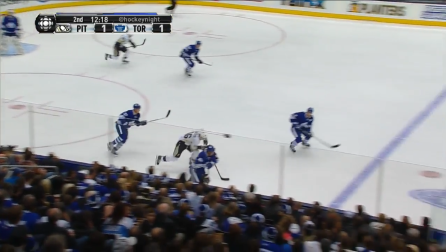
There are two Penguins in behind the Leafs, who have a 4-on-3 heading into the neutral zone. The Leafs look like they're in pretty good shape here.
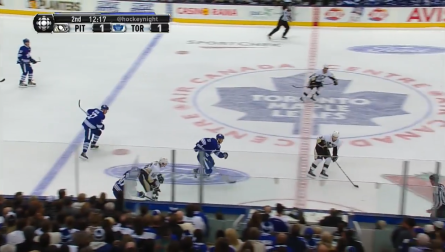
But the Penguins do a great job of not giving the Leafs room to make a play and get the puck into open ice, where Jake Gardiner could take advantage of his great skating to fly through the neutral zone. The primary thing to notice here is that the Penguins defencemen are playing up at the red line, and they're both on the half of the ice that the Leafs have the puck on. The Leafs wind up with nowhere to go, and the Penguins get the puck here.
Here's another example of how the Penguins D stands up players in the neutral zone.

The Leafs defenceman has the puck and is going to pass it up through the neutral zone to the left winger.
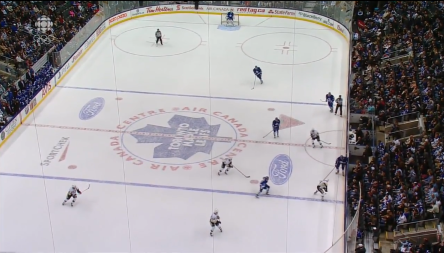
But Rob Scuderi steps up, causing a turnover. Also note how many Penguins are in the vicinity of the puck: 4 of them. Even if the Leafs winger (David Clarkson in this case) receives the pass successfully, there's nowhere for him to go with it.
Now how do the Leafs defend an extremely similar play in the same game?

The Penguins start from the same spot: defenceman has puck and will pass to the winger on the same side.

Look how far back Paul Ranger is. And watch where he goes.
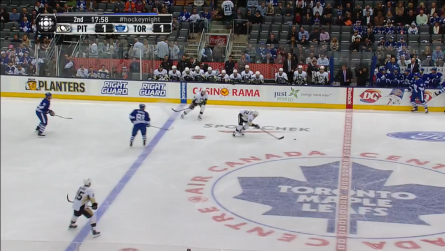
As you can see, Ranger is still moving backward, leaving a huge gap. The Penguins forward actually bobbles the puck here, but because there are no Leafs in his vicinity, he makes an easy recovery and the Penguins end up moving the puck forward. This is one of the major differences I noted between the two teams: when defending a long pass through the neutral zone, the Leafs defencemen would typically back off into their own zone, while the Penguins defencemen nearly always closed the gap so that the recipient of the pass had to get rid of it immediately (often via a dump-in).
To give some idea of how well the Penguins cut off space in the neutral zone when Bylsma was coaching, here's how quickly they repeatedly surrounded the Leafs in just 4 seconds.

Three Penguins converge around the puck.
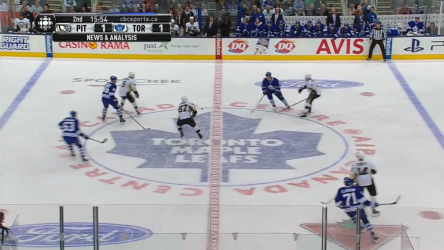
The puck has moved across the ice, but the Penguins still have three (different) players surrounding the puck.
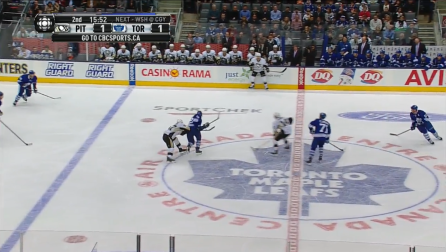
Just a couple seconds later, but the Penguins have created another triangle around the puck. There's nowhere for the Leafs to go, and the Penguins get the puck back and go on the attack.
The Penguins are constantly outnumbering players in the neutral zone, forcing turnovers or dump-ins. My original theory was that the Penguins prevented entries by standing up players at the blue line, but it actually happens further up ice. Many of the Leafs' dump-ins in this game came well before the blue line, as the Penguins cut off their space in the neutral zone. Preventing zone entries, in the Penguins case, happens long before the puck gets to the blue line. Conversely, the Leafs allowed a lot of entries with control because the Penguins frequently had space and speed coming through the neutral zone, forcing the Leafs defencemen to back off.
Paint A Vulgar Picture
You may reasonably be wondering if the problems that the Leafs had defending the neutral zone last year are still present. Based on re-watching a couple of recent games, I would say that they're less prevalent, but still present. The Leafs still don't have anything like the structure in the neutral zone that Bylsma's Penguins had. Let's look at a couple of examples.
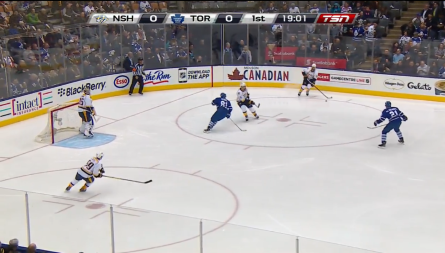
Phil Kessel and James Van Riemsdyk are both converging on the puck. Tyler Bozak is out of the frame, well back of JVR, presumably in good defensive position. But wait for it . . .

For some reason, Bozak is standing behind JVR on the same side of the ice as JVR and Kessel. The Predators have an easy pass across the ice, and now Roman Josi has an astonishing amount of room to skate with no one putting any pressure on him. The defencemen are forced to back off.
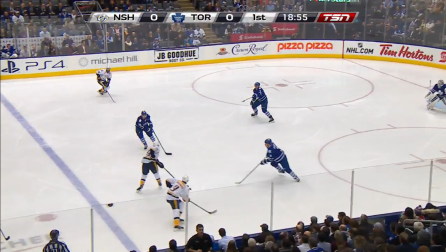
This is the first time anyone on the Leafs has gotten anywhere near Josi since he got the puck back at his own faceoff circle. Dion Phaneuf and Cody Franson have had to back way off as Josi races forward with speed, and the Leafs are outnumbered. Bozak has only just gotten back into the play here, but even though it may look like it, he isn't actually in position to defend Josi. Josi makes a drop pass, and the Predators wind up in great position to get off a scoring chance.
Here's another example from a recent game, this time against the Penguins.
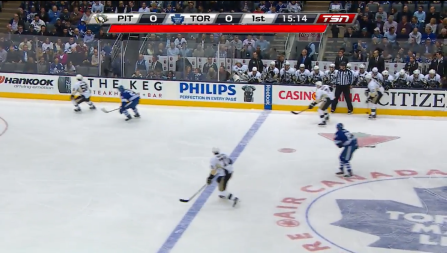
The Leafs seem to be in reasonably good position here, but that doesn't last long.
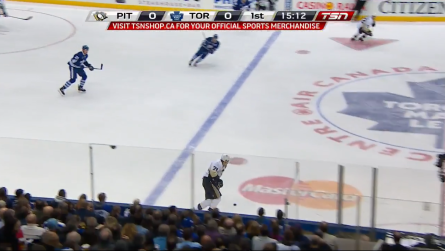
While Kessel's play here isn't that smart, Bozak's decision is mind-boggling. Even though he's behind Kessel, out of the frame in the first screenshot, two seconds later he's behind four Penguins, trailing the play (that's Bozak just under the score banner). Now all three Leafs forwards are caught deep, and the Penguins have a ton of room in the neutral zone. Oh, and the puck is on Evgeni Malkin's stick.
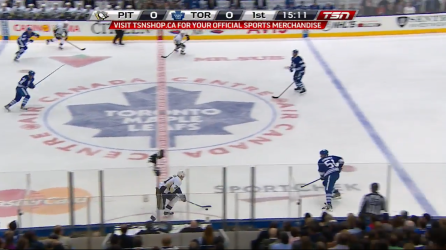
The Leafs defencemen have little choice but to back off here, as they have no support from the forwards and Malkin is flying through the neutral zone with speed and room.

The Penguins gain the zone with possession, but Gardiner actually plays this very well. Despite the fact that Malkin is coming at him like a freight train and has tons of room to make a play, Gardiner steps up and takes away all of Malkin's room. However, because the Leafs have no back pressure from the forwards, Hornqvist gets the puck and is able to get a shot on goal.
How Soon Is Now?
Exactly how much of the Leafs problems in the neutral zone is personnel and how much is tactics isn't entirely clear. The Penguins' top forwards are certainly better defensively than the Leafs' are. And part of the problem for the Leafs is clearly that Tyler Bozak makes some baffling decisions; while the Leafs are somewhat passive in the neutral zone in general, I had a hard time finding plays made by Kadri or Santorelli that were as bizarre as the ones Bozak makes. But in general, the Leafs look far less disciplined and structured in the neutral zone than the Penguins did under Dan Bylsma.
The Leafs have a number of issues, but allowing too many shots is definitely at the top of the list. They seem to lack structure in the neutral zone, with forwards often getting caught behind the play and failing to take away space from the puck-carrier in the neutral zone. The Penguins last year, on the other hand, did a fantastic job of swarming the neutral zone and forcing turnovers and dump-ins. On the basis of that, I'd say that hiring Dan Bylsma would go a long way towards fixing the Leafs' problems in preventing zone entries with control.

Comment Markdown
Inline Styles
Bold: **Text**
Italics: *Text*
Both: ***Text***
Strikethrough: ~~Text~~
Code: `Text` used as sarcasm font at PPP
Spoiler: !!Text!!